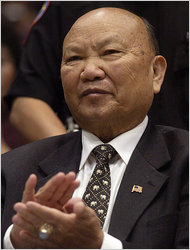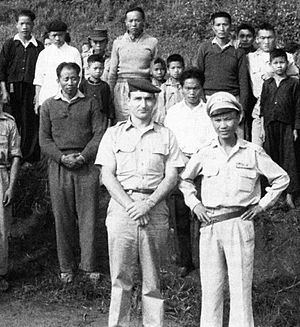Vang Pao facts for kids
Quick facts for kids
Vang Pao
|
|
|---|---|

Vang in 2004
|
|
| Native name |
Vaj Pov
|
| Born | 8 December 1929 Xiangkhouang, French Indochina |
| Died | 6 January 2011 (aged 81) Clovis, California, U.S. |
| Allegiance | |
| Service/ |
|
| Years of service | 1940–1975 |
| Rank | Major general |
| Commands held | GCMA Laos "Secret Army" |
| Battles/wars | Second Sino-Japanese War First Indochina War Laotian Civil War Second Indochina War |
| Nationality | Hmong, Laotian |
Vang Pao (in Hmong: Vaj Pov; 8 December 1929 – 6 January 2011) was a very important leader. He was a major general in the Royal Lao Army in Laos. He was also a respected leader for the Hmong American community in the United States. Many people in the Hmong community called him General Vang Pao.
Contents
Early Life and Education
Vang Pao was born on December 8, 1929. He was from a Hmong village called Nonghet. This village is in the northeastern part of Laos. His father, Neng Chu Vang, was a local leader there.
Vang Pao grew up as a farmer. But his life changed when Japanese forces took over French Indochina during World War II. His father sent him to school when he was 10 years old. He studied until he was 15.
After school, he started his military career. He joined the French Military. He wanted to help protect the Hmong people from the Japanese invasion.
Military Career and Leadership
Vang Pao was the only Hmong person to become a General in the Royal Lao Army. He was very loyal to the King of Laos. He also strongly supported the Hmong people.
During the 1960s and 1970s, he led a group called the "Secret Army." This army was also known as the Hmong Army. The Central Intelligence Agency (CIA) helped train and support them. They fought against the Pathet Lao and the People's Army of Vietnam.
After 1975, the Lao government took control. Many Hmong and Laotian soldiers who fought with Vang Pao, and their families, became refugees. The United Nations helped them. They were allowed to move to countries like the United States, France, Australia, and New Zealand.
Many of Vang Pao's former soldiers later formed groups like the Lao Veterans of America. These groups help Hmong and Laotian veterans and their families.
Moving to the United States
Vang Pao moved to the United States in 1975. This was after the communists took power in Laos. He and his wife, May Song Vang, first lived in Montana. Later, they settled in California.
He was still highly respected by the Hmong people. Many Hmong-Americans looked up to him. They valued his leadership and military achievements.
While living in the U.S., Vang Pao worked with other Lao and Hmong leaders. They created the United Lao National Liberation Front (ULNF). This group wanted to bring attention to problems in Laos. They also supported resistance against the government of the Lao People's Democratic Republic.
Vang Pao and his allies helped stop the forced return of Hmong refugees from Thailand to Laos. This was a big win for human rights. Thousands of refugees were allowed to move to the U.S. instead.
Vang Pao often spoke about human rights issues in Laos. He was invited to talk at the U.S. Congress. He spoke about the challenges faced by the Hmong and Laotian people.
Legal Challenges and Support
In 2007, Vang Pao and others were arrested. They were accused of planning to overthrow the government of Laos. This was part of a federal investigation.
Many people, including Hmong, Mienh, and Lao communities, protested these arrests. They rallied in different states. They called for Vang Pao's release.
Release from Jail
On July 12, 2007, a California court ordered Vang Pao's release. He was released on a US$1.5 million bond. His family members helped secure the bond with their property.
Charges Dropped
On September 18, 2009, the U.S. government dropped all charges against Vang Pao. They stated that they could consider the possible outcomes if he were convicted. This decision was welcomed by his supporters.
Before his arrest, an elementary school in Madison, Wisconsin was planned to be named after him. After the charges, the school district decided not to use his name. However, in 2012, the Fresno Unified School District voted to name a new elementary school after him. This happened the year after he passed away.
Personal Life
Vang Pao had a large family. He reportedly had at least 25 children. He spoke English in addition to his native Lao.
His wife, May Song Vang, became a public figure for the Hmong community after his death.
Death and Legacy
Vang Pao had health issues, including diabetes and heart disease. He passed away on January 6, 2011, at age 81. He died from pneumonia with heart problems in Clovis, California. He had been in the hospital since December 26, 2010.
Traditional Hmong funeral services for Vang Pao lasted for six days. They were held in Fresno. Over 40,000 people attended his funeral.
There was a request to bury Vang Pao at Arlington National Cemetery. However, a committee voted against it. He was later buried near Los Angeles at Forest Lawn Cemetery in Glendale, California.
After his death, Vang Pao's contributions to U.S. national security during the Vietnam War were honored. Memorial ceremonies were held at Arlington National Cemetery in May 2011. These events recognized his important role.
See also
 In Spanish: Vang Pao para niños
In Spanish: Vang Pao para niños
- Lao Veterans of America
- Lao Human Rights Council
- The Center for Public Policy Analysis
- Battle of Lima Site 85
- Groupement de Commandos Mixtes Aéroportés
- History of the Hmong in Fresno, California
- Ban Phou Pheung Noi
- History of Laos since 1945
- Ho Chi Minh trail
- Laos Memorial
- Lee Lue
- North Vietnamese invasion of Laos
- Raven FACs


